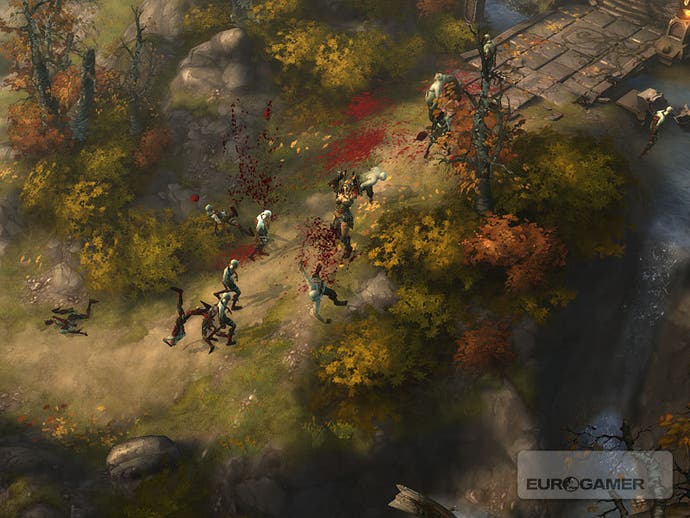Diablo III
Blizzard's next blockbuster dissected.
Alongside the Barbarian, Blizzard showed off the Witch Doctor, an all-new class. As with all the other classes, it will be available in both male and female models - a first for the series - but without character customisation, Blizzard remaining focused on instantaneous action with this sequel. The Witch Doctor is a colourful voodoo necromancer who can summon mongrels (those "zombie dogs") out of the ground to do his bidding before detonating them, hurl explosive skulls, belch poisonous locust swarms, scatter enemies in fear, and raise walls of zombies to defend him. He's almost a one-man RTS blitzkrieg tearing through the action-RPG fracas. "We focused on making the characters as over-the-top as possible," says Wilson. No kidding.
"I would say the biggest thing [that will surprise players] is our emphasis on the RPG and the story," says Pardo, however. "That's something that people haven't expected out of the Diablo series, they've kind of palmed it off as a light RPG at best, and I think there's an opportunity to bring a lot more story and RPG elements - without slowing down the action, which is essential."
It's not an easy balance to find. Blizzard is adding a conversation system, and voice to the player characters; key exchanges happen in crisply-defined, inset windows with the participants looming large, similar to comic-book panels. Lead world designer Leonard Boyarsky - previously a creator of the Fallout series at Interplay - says he wants Diablo III's story to be an "opt-in" experience, as it is in other Blizzard games: rich and detailed if you look for it, unobtrusive if you don't.

Diablo III begins 20 years after Diablo II, in New Tristram. Hell's invasion of the world, as prophesied by the series' star NPC Deckard Cain, never happened, and the horrific events of the first two games are regarded as legend by a young population that never experienced them; for psychological and political reasons, the world of Sanctuary, which has built a new capital in the trade centre Caldeum, is in a collective state of denial. Apart from Cain himself, naturally, who, driven by guilt, has been researching the war between heaven and hell, and who kicks the adventure off once more. We know that the rogue angel Tyrael, who helps man against heaven's wishes, will be involved, but we don't know how.
Wilson promises that there are some major new systems that we don't know about yet that will come as "really big surprises". "I'd have to say the coolest feature, we didn't show," he says, and his huge grins and pregnant silences when asked about talent trees and the rune system make us think these might have something to do with it. On top of the mountain of things we don't know about Diablo III, we have to heap what we don't know about Blizzard's online gaming platform, battle.net, which is due a major revamp alongside the launch of StarCraft II and will certainly have a major impact on Diablo III as well.
There are, however, a few more details to hoover up. Co-op play will be drop-in, drop-out. The skills hotbar combines with mouse-wheel selection to make much more tactically diverse play much simpler. All loot that drops will be for the player that sees it, so no more squabbling. There will be some form of new trading system, including easier ways to trade between your own characters, Blizzard recognising that the ad-hoc system in Diablo II wasn't really good enough. There will be "something like" World of Warcraft's Armory, an online database for items, characters and equipment. There will be several difficulty levels, although there's no decision on a permanent-death "hardcore" mode yet. It will be similar in length to Diablo II.

And it won't be appearing on consoles. Well, it's not planned. When asked, Pardo stops well short of slamming the door. "I think it's theoretically possible. It would have some control changes that I think you'd have to make... You'd need to think about a lot of the point-and-click spells, like point to area-of-effect, or things like line-damage in this direction. Target selection is something you're going to lose on console, you're really going to be able to do targeting direction, but not specific targeting." So it would need a complete redesign? "Oh, I don't think it would be a redesigned game," he says firmly. "Out of StarCraft, Warcraft or WOW, Diablo would be the easiest game to translate. But it would still take a bit of work."
Four years into development, in the greatest secrecy, far from its original home in the now-closed Blizzard North studio, with many of its leading lights long gone, Diablo III can't help but be a different game, no matter how similar it looks. It's more, alright: more logical, more sophisticated, more physical, more accessible, more instantly appealing, more like Diablo than either previous Diablo game, if that's possible. And - dare we say it? - it's already looking a whole lot better.


.png?width=291&height=164&fit=crop&quality=80&format=jpg&auto=webp)




.jpg?width=291&height=164&fit=crop&quality=80&format=jpg&auto=webp)
